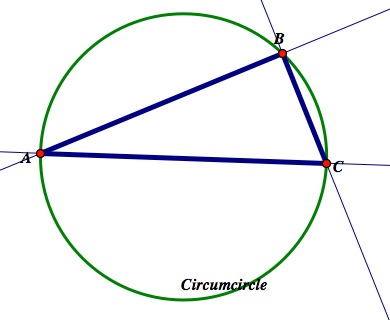
Jim Wilson
Mathematics Education
. . . a work in progress . . .

Jim Wilson
Mathematics Education
. . . a work in progress . . .
GSP LESSONS
These are examples of using GSP to present lessons using "show/hide" buttons. Each is based on the exploration of a problem.
GSP Lesson 1.
Given two lines and a point "between" them. Construct all circles through the point and tangent to each of the two lines. The case of intersecting lines is shown here. Another case would be for two parallel lines in the same plane.
GSP Lesson 2.
Find the shortest path between two points on opposite sides of the river when crossing the river must be done on a path perpendicular to the banks.
GSP Lesson 3.
Given two circles of different radius that intersect. If E is one point of intersection, construct a line through E that cuts off chords of equal length in the two circles.GSP Lesson 4a.
What is the locus of the midpoint of a line segment of varying length where one end is fixed and the other end moves around a circle?GSP Lesson 4b.
What is the locus of the midpoint of a line segment of varying length where one end is fixed and the other end moves around a triangle? Generalize to movement around any closed path.GSP Lesson 4c.
What is the locus of the midpoint of a line segment of varying length where each end of the segment moves around a circle?GSP Lesson 5.
Given two points A and B on the same side of a line k. If C is a point on K, construct the location of C so that AC + CB is a minimum.GSP Lesson 6.
If the base and area of a triangle are fixed, find the triangle with minimal perimeter.GSP Lesson 7a.
Take any parallelogram and construct squares externally on each side. Prove that the centers of the four sqares are the vertices of a square. Show that the area of this square is always greater than or equal to twice the area of the parallelogram. When is it twice the area?GSP Lesson 7b.
Take any parallelogram and construct squares toward the inside of the parallelogram on each side. Prove that the centers of the four sqares are the vertices of a square. Is there a relationship of the area of this square to the area of the parallelogram.GSP Lesson 8.
Given three line segments that are the lengths of a point E from the vetrices A, B, and C or an equilateral triangle. Construct triangle ABC. What if E was a point outside the triangle?GSP Lesson 9.
Construct a triangle of minimal perimeter inscribed in a given acute triangle.GSP Lesson 10.
In an equilateral triangle ABC, let D be the mid-point of AB and E be the mid-point of AC. Extend DE to intersect the circumcircle at point P. Determine the ratio PC/PA. Determine the ratio DE/DP.GSP Lesson 11.
Construct a circle with center O having perpendicular diameters AB and DC. Take the midpoint M of OC and constuct an arc with center at M through A. The arc intersects OD at N. Investigate ON/DN.
Show that AN is the length of the side of a regular pentagon inscribed in the circle with radius OA (i.e., construct the inscribed pentagon, . . . and investigate).
GSP Lesson 12. (Fixed Angle) What is (construct) the locus of the vertex of a fixed angle that is moved such that its sides always subtend a fixed segment AB. That is, given an angle of a specific measure, place the angle so that its two sides always touch points A and B of the segment
GSP Lesson 13
Rectangle circumscribed about an ellipse.Open first GSP file. Open Second GSP File.Run the animations in these files and explore. They should suggest at least the following theorem:
Prove that the vertices of a rectangle circumscribed about an ellipse will lie on a circle. Determine its center and radius with respect to the ellipse.
Problem: For a circle with diameter FB construct a tangent at G. Select points A and B on the circle and construct the tangents to the circle at A and B. Let P be the intersection of these latter two tangents. Construct rays FA, FP, and FB with respective intersections C, D, and E with the tangent at G. Show that CD = DE. What restrictions must be placed on the locations of A and B?
GSP Lesson 15. Given a triangle ABC with its circumcircle. Construct a circle tangent to AB, AC and the circumcircle. (There may be two of them.)
